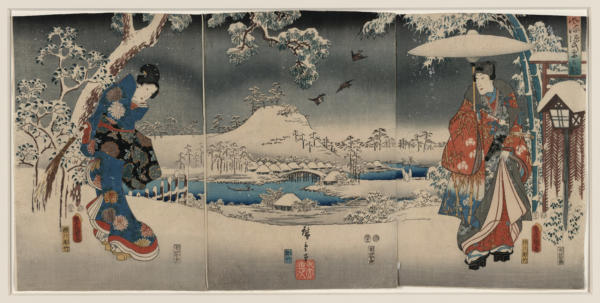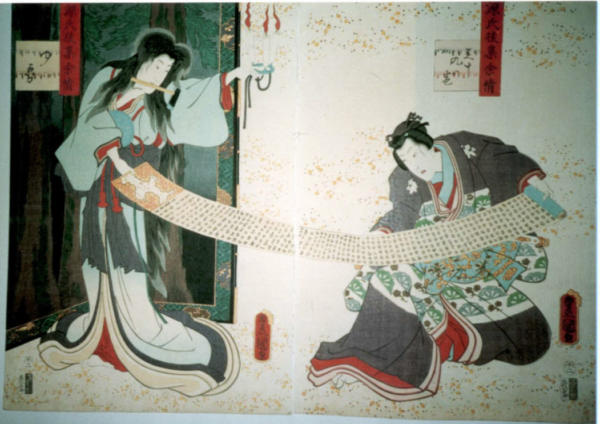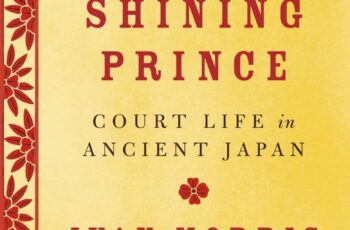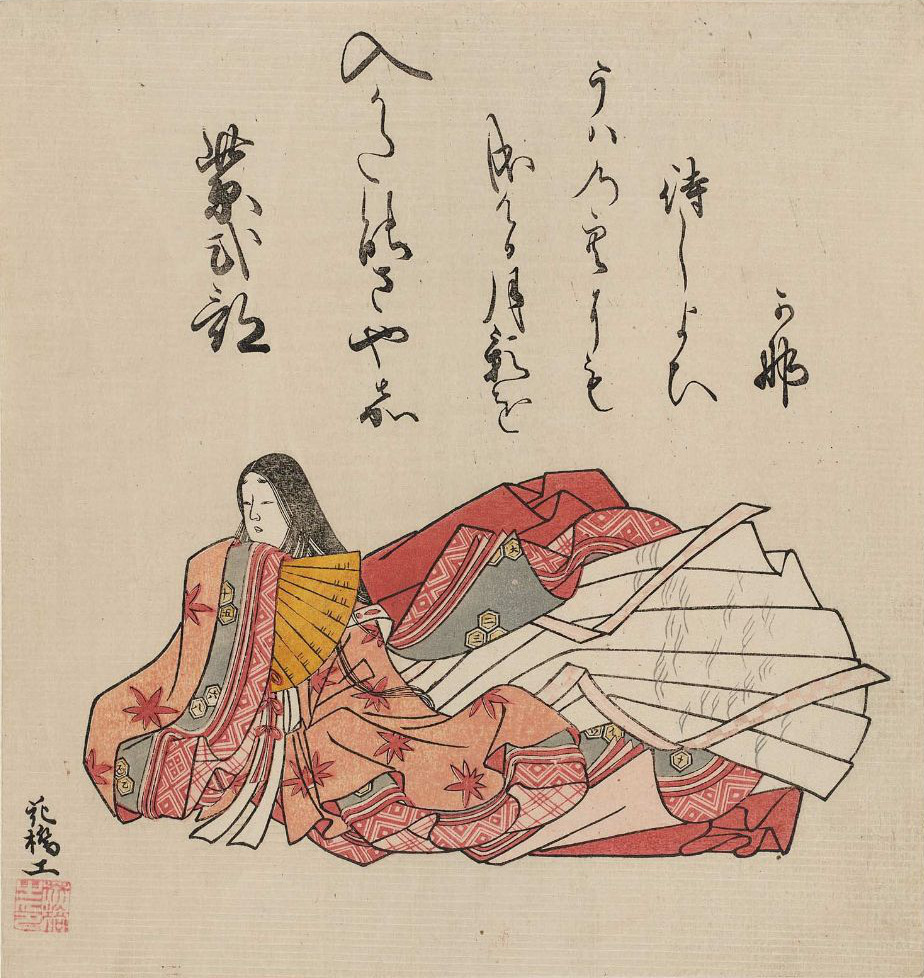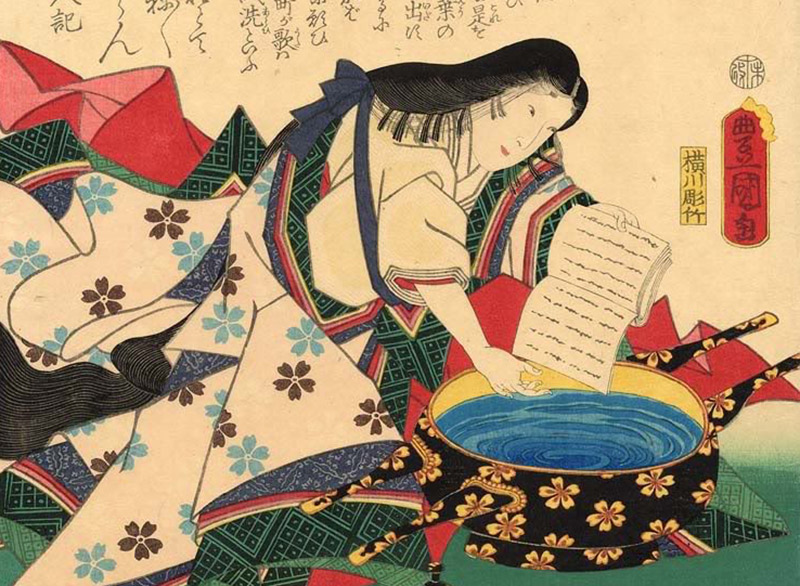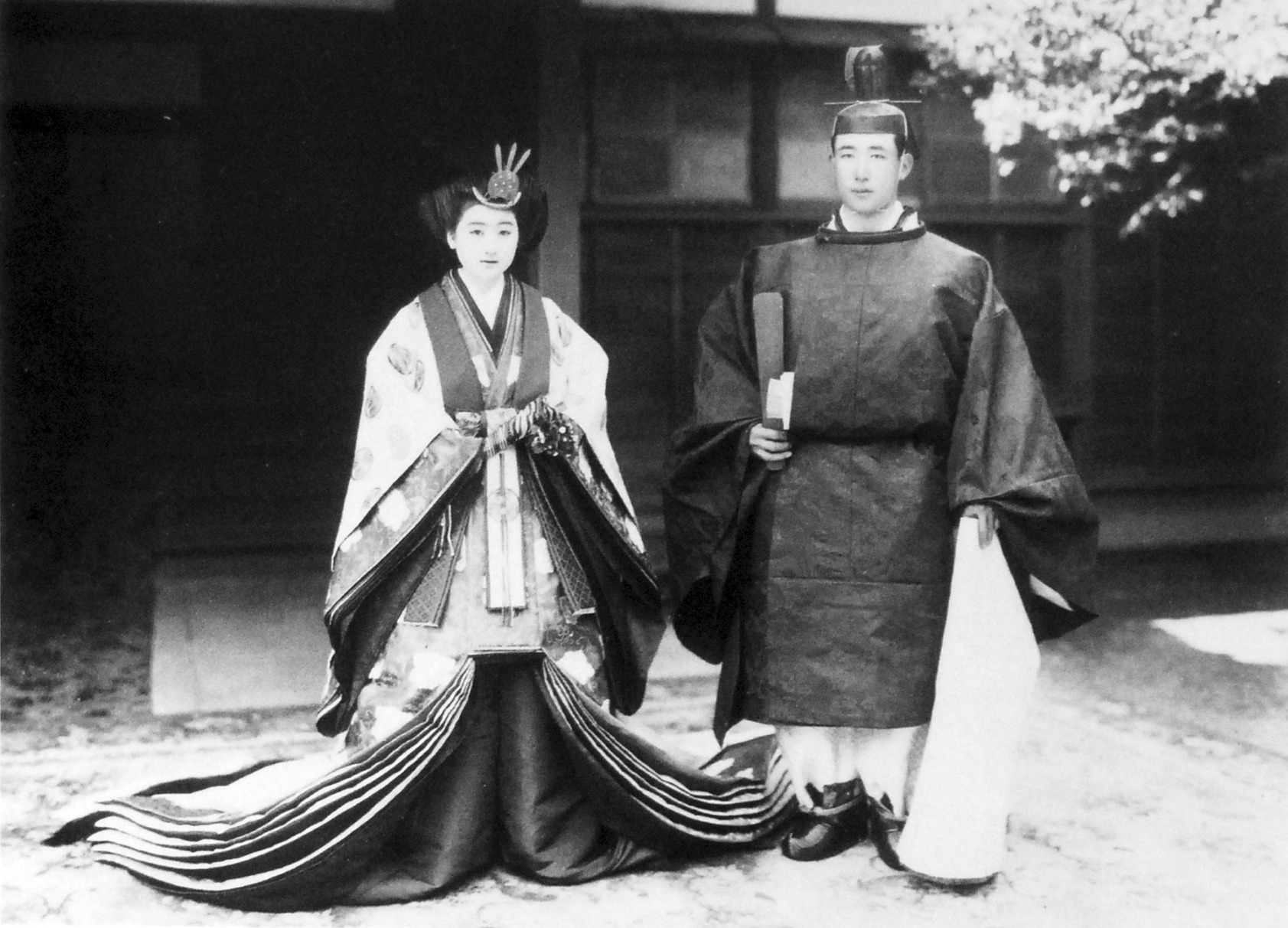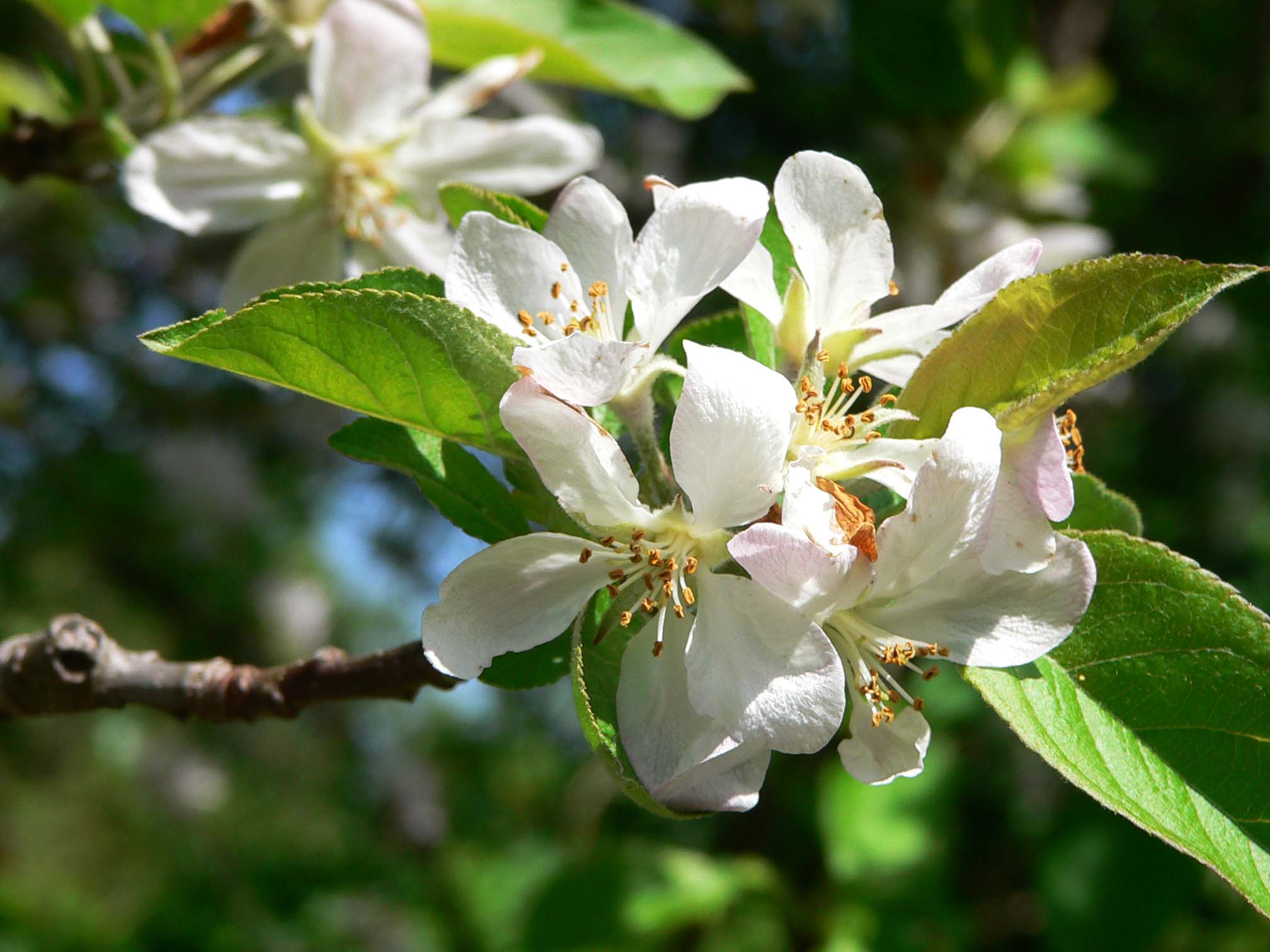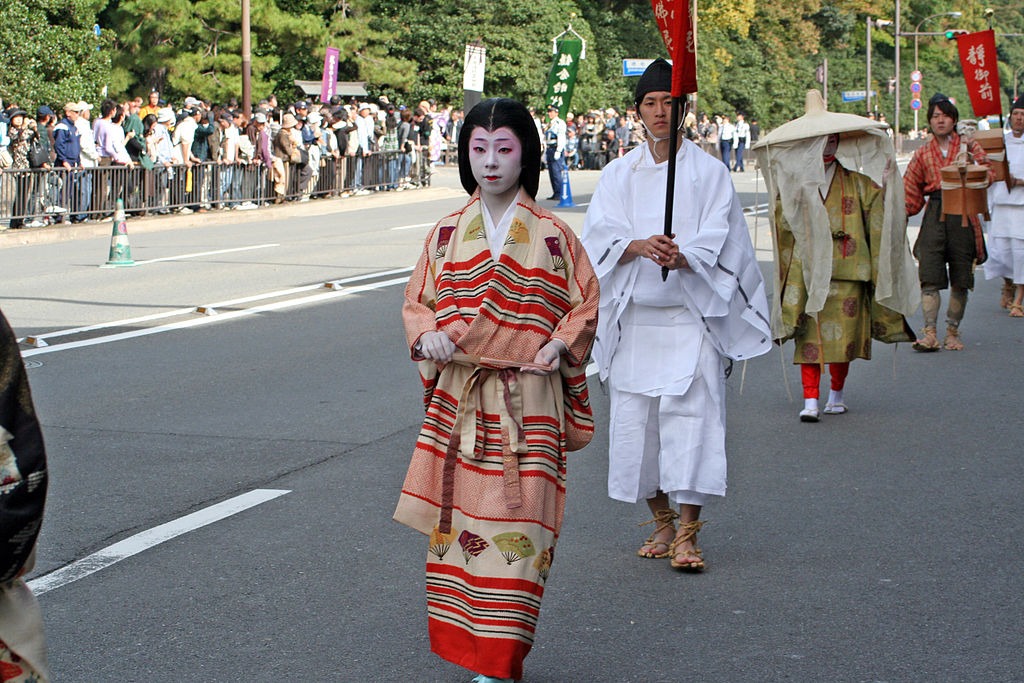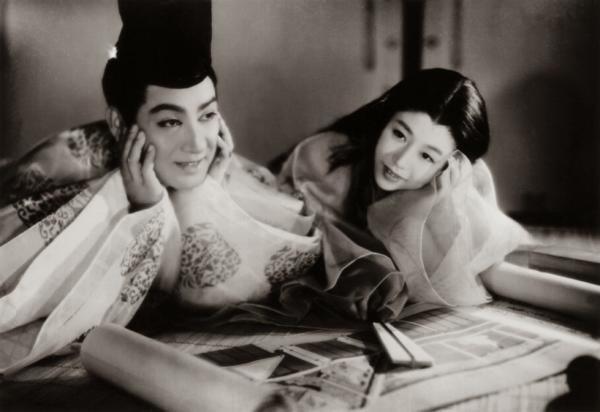 Back in the 11th century, a Japanese woman wrote the world’s first modern novel. The novel remained unknown in the West until after the Meiji Restoration and the rise of modernism in literature. In 1925, Arthur Waley’s translation of the work released, shocking novelists of the time (Phillips, 2010). The Tale of Genji stands as a cornerstone in Japanese literature and world romantic literature, but we know little about the author. Murasaki Shikibu (c. 978-1014) lived as a lady-in-waiting in the Imperial Court during the Heian period (794-1185) (Hirota, 1997). Sadly, that’s the only thing we know that’s certain. Many legends surround her. Ironically, the legends draw a contrast to the dalliances found throughout the Tale of Genji. Stories surrounding Murasaki rarely include romantic relationships.
Back in the 11th century, a Japanese woman wrote the world’s first modern novel. The novel remained unknown in the West until after the Meiji Restoration and the rise of modernism in literature. In 1925, Arthur Waley’s translation of the work released, shocking novelists of the time (Phillips, 2010). The Tale of Genji stands as a cornerstone in Japanese literature and world romantic literature, but we know little about the author. Murasaki Shikibu (c. 978-1014) lived as a lady-in-waiting in the Imperial Court during the Heian period (794-1185) (Hirota, 1997). Sadly, that’s the only thing we know that’s certain. Many legends surround her. Ironically, the legends draw a contrast to the dalliances found throughout the Tale of Genji. Stories surrounding Murasaki rarely include romantic relationships.
These “biographies” are largely fiction. In almost all of them, she expresses loyalty her husband, regardless of the situation. The “Bunkai Bag of Wisdom for Women’s Education” (1749) prefaces one of her legends with (Hirato, 1997):
Murasaki Shikibu is the daughter of Tametoki, the governor of Echizen. Because her father Tametoki was a wise scholar, from a young age she read and studied books, and mastered the texts of Japan and China. She also conveyed the essence of then notion of “concentration and insight” to the scholar-priest of the mount of Tendai, and cultivated the essence of the Buddhist way.
The legend pegs her as a scholar of Tendai Buddhism.
Readers of Genji won’t be surprised at how little is known about Murasaki and how many legends circulated about her. Genji is a dense, difficult work to decipher. As a monogatari, or fictional story, Genji targets noble women. The story makes assumptions that noble women of the Heian period would grasp, but these assumptions leave the rest of us feeling lost. Genji is a part of romance literature designed to be read aloud by women to pass the time. As Prince Genji remarks in the story: “Sometimes I stand and listen to the stories they read to my little one,” Reading stories aloud was a part of Heian period noble lifestyle. Because of its assumptions and design, many Westerners outside of modernist circles viewed the work as trite. Basil Hall Chamberlain and other early Western Japanese scholars viewed it as “long-winded” and “devoid of interest” (Phillips, 2010).
The Setting of Genji
We must understand the Heian period to understand Genji. Chiefly, a fascination in Chinese culture marked the Heian period. The Japanese Imperial Court emulated Chinese fashion and customs while they pursued the arts. A noble was expected to be well versed in literature, poetry, painting, dancing, calligraphy, and more. Genji extends this list by being good at perfume making as well. Noble men used the Chinese language similar to how Medieval European nobles and priests used Latin. In Heian Japan, Women were not allowed to speak Chinese. The period expected women to remain separate from men. They would converse through fabric blinders dividing rooms. Genji shows how great the difference was between the genders by having characters fall in love with each other based on their handwriting.
Indirection defined the Heian nobility, much to our confusion. Murasaki’s lack of direct statements makes the Tale of Genji challenging. It even challenged Japanese scholars to the point where they adopted nicknames for the hundreds of characters in the tale. Murasaki refers to each character by their title rather than by a name. During the Heian period, proper names were considered too blunt for polite use. To make things more complicated, these titles would change over the course of the story. So Japanese scholars pinned their nicknames to clarify who was who. For example, Genji’s son is nicknamed Yugiri, which means “evening mist.” These nicknames appear in English translations as if they are a part of the original story, but Murasaki never used them (Phillips, 2010).
The tale formed a critical part of a noble woman’s education (Naito, 2014). Artists lavishly illustrated scrolls depicting the story, making the story expensive. Because of this, less well-off noblewomen dreamed about owning a copy. In an autobiography, Sarashina nikki (c. 1060), a noblewoman from a rural province writes about this longing (Hirota, 1997):
Brought up in a remote country father even than the Azuma Road, I must have been a terribly countrified child. Yet, how did I start longing for the tales whose existence I could barely imagine? At idle hours of the day or at evening gatherings, as I listened to my sister, stepmother and others talking about this or that tale, or discussing pieces from the Shining Genji, my curiosity increased. But how could they recount from memory enough to satisfy me? Frustrated, I had a statue of Yakushi Buddha built in my size…I prostrated myself and prayed, “Please let us leave for the capital soon. They say there are many tales there—please let me read all of them!
The tale continued to be copied and read by women up until the Edo period when printing techniques expanded Genji’s audience. Male critics panned the Tale. For example, Hayashi Razan (1583-1657) didn’t think the tale was proper literature because a woman wrote it (Naito, 2014).
Did you know cliff notes appeared in Japan? The complexity and length of the story prompted artists in the Edo period to create their own version of cliff notes with simplified plots and story summaries. The rise of woodblock printing widened the audience beyond noble women. The Illustrated Tale of Genji by Yamamoto Shunsho made the tale easier to read by adding punctuation, shorter annotations, and reading guides (Naito, 2014).
Understanding The Tale of Genji
 The reticence of Murasaki and her assumptions make the Tale of Genji difficult to understand. On its surface, the story looks to be a fluffy romance filled with illicit love and a lot of sex. However, the novel has many things going on that can only be seen by looking at what is left unsaid. For example, Genji brings a young girl home with the intent of raising her. During one of these domestic scenes, he finds her coloring pictures. He dabs red paint on his nose to make her laugh. These moments of humanness speak about the lack of humanness found in the elegance of court life.
The reticence of Murasaki and her assumptions make the Tale of Genji difficult to understand. On its surface, the story looks to be a fluffy romance filled with illicit love and a lot of sex. However, the novel has many things going on that can only be seen by looking at what is left unsaid. For example, Genji brings a young girl home with the intent of raising her. During one of these domestic scenes, he finds her coloring pictures. He dabs red paint on his nose to make her laugh. These moments of humanness speak about the lack of humanness found in the elegance of court life.
Under the facade of love, elegance, peace, and high aesthetics, Murasaki hints at a deep wrongness with court life. Genji appears to lack a plot unless you read between the lines. Murasaki does all of her plot work through layers of symbols and through the unsaid. Much of the story focuses on how Genji lost his favor in the Imperial Court and had to be removed by his father, the emperor. This was done to protect him from court politics. After all, his mother was a low-ranked consort. The powerful Fujiwara family pressured the emperor to name the child he had with one of their daughters as heir.
Under the first chapter’s picturesque scenes and romance lurks the threat of rebellion and civil war. Murasaki suggests this at the beginning of the book by alluding to a rebellion in China known as the An Shi Rebellion. This rebellion destroyed the Tang dynasty and left millions dead (Phillips, 2010). After this allusion, the conflict disappears. But its unspoken presence creates dread behind the facade and the character’s actions. They too are on the verge of a conflict that could end a dynasty.
At one point, Genji falls in love with his father’s new wife. Genji eventually seduces her, and people mistake his son for his Father’s son. The boy takes the throne later in the story. Despite not saying it, Murasaki suggests Genji regrets his seduction and how it betrayed his father. His act throws the entire line of succession in doubt. Throughout Japanese history, the emperor was thought to be a descendant of the gods. Genji’s son breaks this line for the first time in 1500 years (Phillips, 2010). While we miss the event, the significance would be evident for anyone who lived in the court at the time. The event casts a shadow over the underlying plot and behavior of the characters.
After his father’s death, Genji goes on and has an affair with a daughter of the Fujiwara family, who now controls the court as a regency. In a rare event, Murasaki as the Fujiwara outright state what was unspoken throughout the early chapters:
The Empress Mother’s countenance nevertheless failed to lighten. She could not have Genji pointedly mocking and belittling her by brazenly invading her house while she was at home, so nearby, and this gave her a fine reason to set in train the measures to accomplish his downfall.
Murasaki’s love for the unspoke extends toward Genji himself. About 3/4 through the story, Genji dies. His death comes after he retires from the world as a monk, a common practice for Heian period nobility (Phillips, 2010). The last years of his life do not appear in the story; a blank chapter marks his death. The following chapter picks up 8 years after Genji’s death and focuses on two of Genji’s descendants. Genji’s subtle last years and death, however, doesn’t end Genji’s story. Throughout the last chapters, the story becomes far grimmer and darker. The death of Genji infects the story with a sadness that the thin veneer of beauty and courtliness can’t hide any longer.
The Tale of Genji ends without the closure those of us in the West expect. The tale ends with a young girl, chased by Genji’s descendants Niou and Kaoru, throwing herself into a river to escape them. A group of monks finds her alive, but she can’t remember what happened. When she finally does, the book ends. The abrupt ending and lack of closure troubles modern readers. It doesn’t feel finished. Yet, when you look at the story as a whole, with its veneers and suggestions, the ending fits. Murasaki expects us to see through the veil and fill in the gaps. The ending’s cut off also fits the darker mood of the last portion of the tale. Death couldn’t save the girl from the flowered conflict swirling about her.
The Strangeness of the Tale of Genji
When I read Genji, Murasaki’s reticence struck me. Despite the dalliances of Genji and the general frivolousness of the tale, I felt something was wrong. The entire novel has a pall, a darkness, overlaying it. The characters feel devoid of hope or direction despite their cultivation. An emptiness pervades their behavior, and they appear to be aware of it but unwilling to face it. Murasaki’s genius shows in how she weaves all of this through suggestion alone. The blank chapter that stands in for Genji’s death stuck me. Its silence says more than the most purple prose could.
The complicated nature of the text, with its tangled relationships and emotions, is designed to stimulate discussion. Much of the text is open to interpretation. This makes sense. Heian women were shut off from the world. Boredom was a struggle. A complex, interpretive text like the Tale of Genji would allow them to imagine and discuss the story for years. The longevity of the text and the fact the text has seen over 20 manga adaptions attest to this (Myake, 2008).
The story influenced Japanese art. Genji-e scrolls from the 12th century influenced the Edo period’s woodblock prints, particular that of Utagawa Kunisada. In turn, Utagawa would influence the modern manga adaptions of Genji (Myake, 2008).
You can read Genji as a fluffy romance full of affairs or as a darker story of people attempting to ignore the frivolousness of their lives and looming catastrophes. Without some knowledge of Japanese history, The Tale of Genji makes for a difficult read. Despite the difficulty of understanding the unstated, The Tale of Genji stands as the first novel and speaks about the importance of women’s contributions to world culture.
References
Hirota, A. (1997). The Tale of Genji: From Heian Classic to Heisei Comic. Journal Of Popular Culture, 31(2), 29-68. doi:10.1111/j.0022-3840.1997.00029.x
Miyake, Lynne (2008) Graphically Speaking: Manga Versions of the “Tale of Genji” Monumenta Nipponica. 63(2) 359-392.
Naito, Satoko (2014) Beyond the Tale of Genji: Murasaki Shikibu as Icon and Exemplum in Seventeenth and Eighteenth Century Popular Japanese Texts for Women. Early Modern Woman 9 (1). 47-78.
Phillips, Brian (2010) The Tale of Genji as a Modern Novel. The Hudson Review. 63(3). 373-390.
